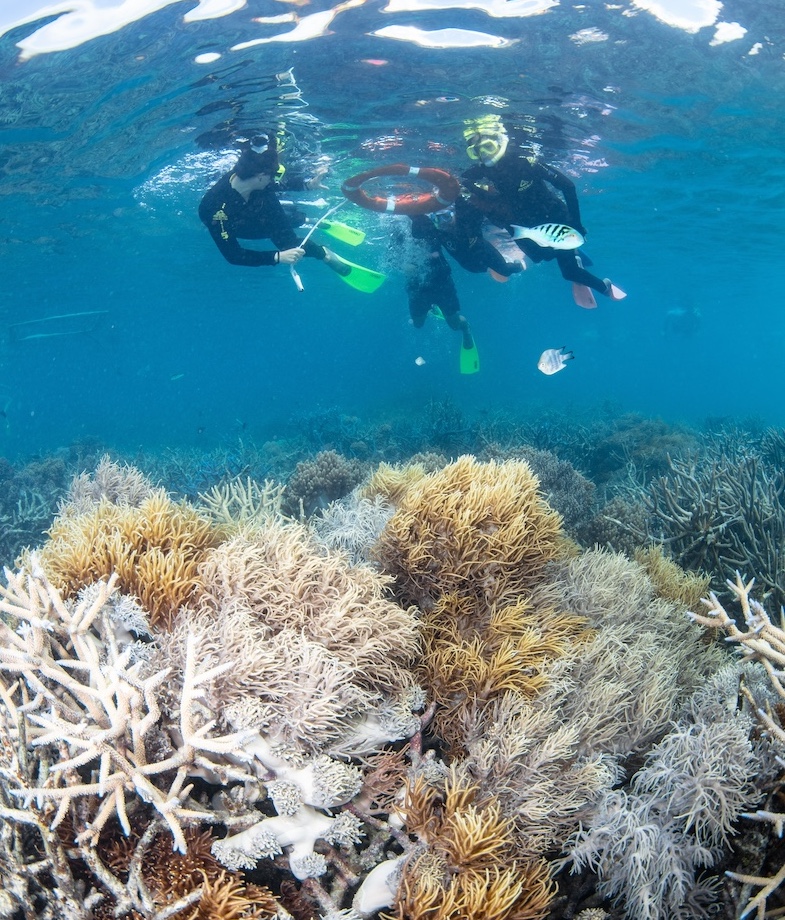
The white coral shows the extent of damage to the Great Barrier Reef. Photo compliments of Great Adventures Tours in Cairns, Australia.
By Liz Campbell
“This is the biggest, baddest coral reef in the world,” says ‘Just call me Tom’, one of the Great Adventures boat crew. “It’s one of the Seven Wonders of the Natural World!”
Even in a country rather inclined to superlatives, Tom isn’t exaggerating. After all, this is Australia, Earth’s lowest, flattest, and oldest continental land mass, home to some of the world’s most unique creatures. And our boat is undoubtedly heading out to the world’s largest coral reef – a spine of 3,800 reefs stretching more than 1,400 miles along Australia’s east coast.
Declared a UNESCO World Heritage site in 1971, the Great Barrier Reef incorporates more than 400 types of coral. This reef is one of the most biodiverse ecosystems on the planet, home to thousands of sea creatures, including six of the seven species of the world’s sea turtles. Sir David Attenborough, who donned scuba gear to see it, called it “the single most revelatory moment of my life”.
Not a scuba diver, I donned a wet suit (a precaution against jellyfish stings) and snorkel gear. Having explored reefs in the Caribbean and off the coast of Malaysia, I was expecting to see vibrant colors. I’m not disappointed – it’s a Matisse paint box gone mad. Amongst yellow sponges and swaying green sea grass are splashes of pink, red, purple, and blue. Small schools of blue tang, and pink-hued parrot fish dart about. There’s even a huge, brown wrasse, its protruding forehead and thick lips making it one of the ugliest of reef creatures.
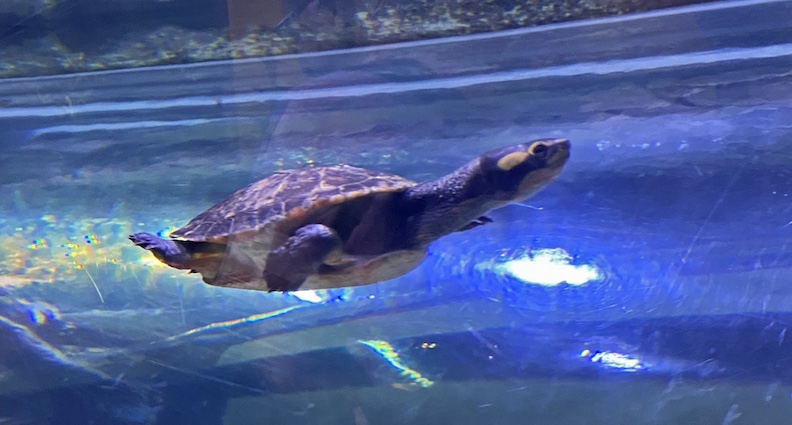
Australia’s Great Barrier Reef off the coast of Queensland is home to thousands of sea creatures, including six of the seven species of the world’s sea turtles. This turtle seems happy to have the Cairns Aquarium as his new home. Photo by Liz Campbell
Barrier Reef in the Balance
But I’m surprised to see that large stretches of this coral are white, the bleached skeletal remains of a once vital organism. Sadly, this reef, vast as it is, is slowly becoming one of the victims of climate change and the carelessness of humans. Rising sea temperatures and severe weather events caused by the former, and pollution and damage by the latter, are destroying the coral. And the destruction is happening at an alarming rate.
David Attenborough has raised the alarm. “The Great Barrier Reef is in grave danger,” Attenborough has said. “If temperatures continue to rise at the present rate, it will be gone within decades. What was once unthinkable is now happening on our watch.”
And it’s a concern being raised around the world. According to the Smithsonian magazine, ‘half of coral reefs have been lost since the 1950s. Scientists say climate change, overfishing and pollution are decimating these fragile ecosystems and putting communities and livelihoods in jeopardy.
Huge efforts are being made to repair the damage being done, but those who work with tourists on this extraordinary reef are very aware of its fragility and want us to spread the word. I will, but as we head back to Cairns, I can’t help being on a high.
Next stop: the magnificent Cairns Aquarium to learn more about this amazing underwater world. Here, there’s a miniature version of the Great Barrier Reef where one can discover the intricacies of the ecosystem created by reefs. Among the creatures to be seen in this aquarium are sea turtles (there’s even a sea turtle breeding program), and sharks. Sadly, I didn’t see a sea turtle in the wild, but I didn’t mind missing a close sighting of a shark. As I discovered in Malaysia, even non-threatening species of shark are frankly terrifying when encountered in the ocean.
A stroll through Cairns
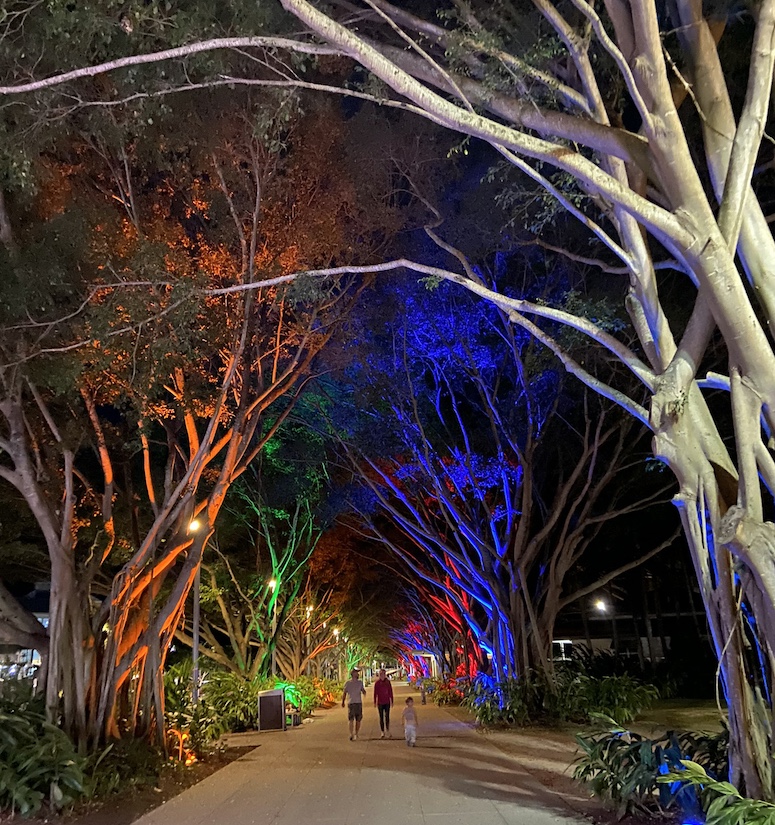
Cairns Esplanade at night. Photo by Liz Campbell
Back on shore, the pretty town of Cairns is worth exploring. Begun as a mining town in the 19th century, during World War II, the city became a staging ground for the Allied Forces in the Battle of the Coral Sea. St. Monica’s War Memorial Cathedral here commemorates the war with a series of truly unique stained-glass panels. Unusually these have eschewed the usual religious iconography and instead, showcase the devastation of war in brilliantly colored panels.
The Cairns Museum describes the history of the town and includes that of its indigenous community. These are the Yirrganyidji, known as the Saltwater people, who once traveled the coast in outrigger canoes, hunting, fishing and trading with neighboring communities. The museum is part of the Shields Street Cultural Precinct, a pedestrian area in a very walkable, very social town. This large open area is also the gathering place for street fairs and events.
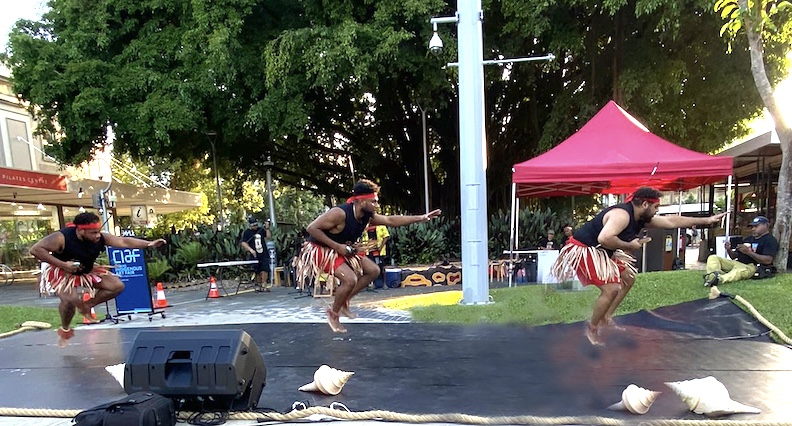
Dancers from the Indigenous Art Fair perform in the Shields Street Cultural District in Cairns. Photo by Liz Campbell
Here, we watched performances by dancers, storytellers and musicians sponsored by the Cairns Indigenous Art Fair. The audience gathered around the square was invited to participate in dancing and singing lessons, which many did with great enthusiasm.
A huge Ferris wheel dominates the seafront Esplanade, overlooking the lagoon beach and a giant swimming pool. Opposite, the shaded storefronts of shops and restaurants offering a selection of international cuisines provide a welcome respite from the sun. At sundown, colorful lights in the trees and on the giant wheel make the Esplanade a fairyland, perfect for a romantic stroll, accompanied tonight by the guitar and cello of a pair of buskers.
Apart from the charms of the town itself, from here one can visit two UNESCO World Heritage sites, each recognized for its rich and unique biodiversity. In 1988, the Wet Tropics of Queensland joined the Great Barrier Reef on UNESCO’s list. Stretching along the northeast coast of Australia for some 450 kilometers, most of this is tropical rainforest. The point where these two UNESCO sites meet is nearby Cape Tribulation Beach.
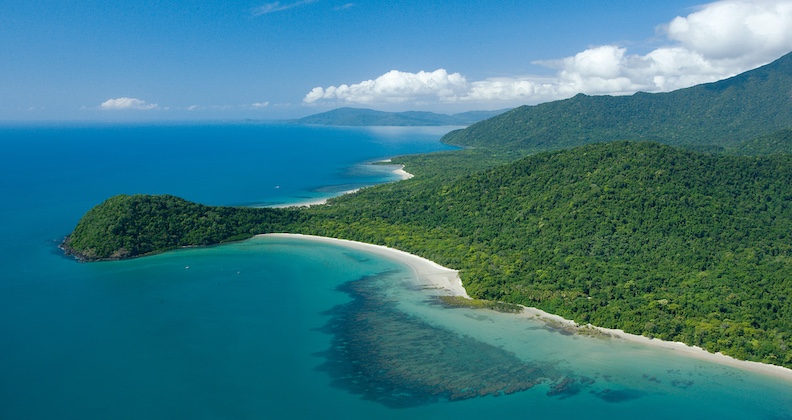
Aerial view of Cape Tribulation Beach that runs along the Cape Tribulation headland that divides Great Barrier Reef Coral from the Daintree Rainforest. Photo courtesy of Tropical North Queensland
You won’t need your swimsuit at this beach. Estuarine crocodiles and marine stingers make this stretch of water one to avoid. Patently one of Australia’s first explorers, and its much-vaunted hero, should also have given this cape a wide berth. After his ship ran aground several times while trying to find his way through, Captain James Cook bestowed Cape Tribulation with its disheartening name, “because here began all my troubles.”
Nonetheless, there’s something rather magnificent about standing at the convergence of two distinctly different ecosystems, each vastly important to the planet. And having visited the reef, I want to see the second.
Into the woods
The Daintree Forest, part of the Wet Tropics, is about 180 million years old. The world’s oldest rainforest, it predates the continental split of Gondwana that created Australia and Antarctica. In 2021, it was returned to the Kuku Yulanji, a rainforest people who have lived here for 50,000 years, in complete harmony with their environment. So taking a Ngadiku Dreamtime walk with an indigenous guide through nearby Mossman Gorge, part of the Daintree, is a must.
Our Yulanji guide, Levi Williams, takes us into the dense forest. “Forget Tarzan,” he says cheerfully. “You won’t be swinging through these trees. There are some that are very poisonous to touch, you wouldn’t want to risk brushing against one of these.” We’re smiling, but this little group is being careful now.
A red cedar tree, our first stop, is a source of dense wood for making boomerangs, club swords, and furniture. Using a stray, flat piece of wood, Levi hammers its trunk, creating a very loud, deep boom. “If you get lost in these woods, this is your mobile phone,” he says. “You hit it three times. That tells others you’re lost or need help.” There’s an additional advantage, he adds with a smile. The cassowary, an aggressive flightless bird, can be frightened away by this noise.
We come upon a rock shelter, the enormous stones seeming out of place deep in the forest which has engulfed them with trees and vines. These can mark places for the initiation of boys, or where elders, like Levi’s own grandfather, would meet to hold discussions.
By a trickling stream, we learn about the markings that Aboriginal people paint on themselves during festivals and gatherings. Mixing iron ochre, kaolin clay, or black charcoal with a little water, Levi quickly creates designs on his arm. “You must do it correctly. These white dots are for the cockatoo, my family totem,” he explains, adding lines to represent the forest and ocean. “We, our people, come from these.”
He conscripts Oliver, a little English boy visiting with his parents. Oliver is soon covering his own arm with markings. The clay contains many minerals including zinc, Levi explains, so it’s not only an effective sun block but it’s also good for the skin. And he adds, pulling some leaves off a branch, “These sassafras leaves can be rubbed on the skin to ease the discomfort of sunburn and insect bites.”
There are stories. And this lush, mysterious forest is the perfect setting for the telling of them. Levi’s gentle voice has us all enthralled with the folklore of his people. Even the young children are spellbound as he describes Manjal Dimbi, the mountain nearby whose name translates to ‘mountain holding back’. Its most prominent peak, just visible through the trees, represents Kubirri, the Good Shepherd, who helped the Kuku Yulanji by holding back the evil spirit, Wurrumbu, keeping them safe.
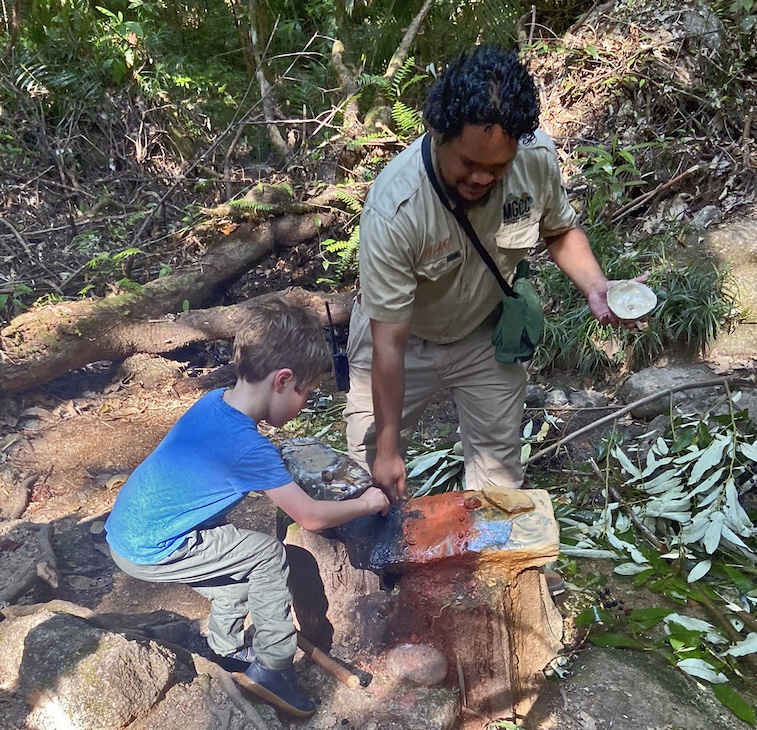
Yulanji guide Levi Williams teaches Oliver, a young visitor, how to use colors from nature to create clan markings. Photo by Liz Cambell
Trees Tell Stories
In this community, Levi explains, there’s a great deal for a young person to learn and a lifetime in which to learn it. Ancient wisdom is passed down from the moment a child is born. “This forest is our university, our hardware store, our pharmacy, even our supermarket,” he explains, showing us black beans and blue quondong beans, both used in aboriginal cooking. “And it teaches us geology and geography and astronomy.”
The most important lessons appear to be about how to live with the forest, how to understand its seasons, and how to preserve it. The Daintree is special. Few places on earth still have as many plants and animals that remain relatively unchanged from their ancestors in the fossil record. But like coral reefs, the earth’s rainforests are rapidly being destroyed. The hope is that under the caring custody of the Kuku Yulanji, this oldest rainforest on the planet will continue to thrive. ![]()

